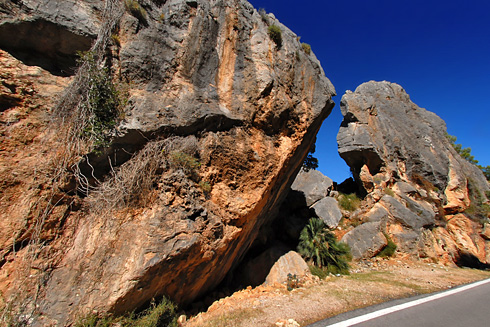The Serra de Tramuntana's fascination appeal
There are landscapes, cities and people that fascinate us for the same mystifying, irrational reasons that might inexplicably account for being in love. They are personal fascinations that each one of us might find impossible to shake off and which are very often neither shared nor even understood by others. Even more inexplicably, there are places that fascinate almost everyone who visits them, for their majesty, singularity or something that goes beyond rational understanding. It is hard to find anyone on his or her first visit to the Serra de Tramuntana who is not struck with a feeling close to fascination. Numerous painters and photographers have left legacies that bear witness to their fascination. Writers have also tried to describe what apparently cannot be described: the beauty of the Serra de Tramuntana's combined mountains and coastal scenery.
One of the strongest fascinations was that of Argentinean writer Julio Cortázar (Brussels, 1914 – Paris, 1984). In his story El rayo verde, he talks of his obsession with the phenomenon of a green ray that he discovered after reading the novel of the same name by Jules Verne. The physical phenomenon referred to by both writers occurs when the sun sets over the sea in a completely clear sky. In these ideal circumstances, the last ray of sun is said to take on a supernatural shade of green that barely lasts for an instant. I do not know whether this green ray is physically possible. Cortázar thought that he saw it on a day out in the Serra de Tramuntana. Let him explain it in his own words: "Yesterday, from Archduke Ludwig Salvator's vantage point, I watched the sun sink into the sea once again. A friend mentioned the green ray, and I was saddened in anticipation of the fact that the children there would await it with the same expectant longing that I had felt in the case of my absurd suburban horizon. Now it would be worse. Now the conditions were right and there would be no green ray. Their parents would explain away the fiasco any way they could to console the little ones. Life, as it is called, would score another goal on the road to conformism. A final fragile orange segment of the sun was left. We watched it disappear behind the sea's perfect edge, enveloped by a halo that would endure for a few more minutes. And then the green ray appeared. It was not a ray but a flash, an instantaneous spark, as if an alchemical fusion point or Heraclitean element-related solution had been reached. It was a bright green spark, it was a green ray even though it was not a ray, it was the green ray, it was Jules Verne murmuring in my ear: 'Did you finally get to see it, you big fool?'

It is hard to find anyone on his or her first visit to the Serra de Tramuntana who is not struck with a feeling close to fascination
Two other writers who were fascinated with the Serra de Tramuntana are the Catalans Josep Pla and Josep Maria de Sagarra. Both visited Mallorca on different occasions and both left written evidence of the extent to which the Serra de Tramuntana had fascinated them. Sagarra recalls his first trip to Mallorca in his Memòries, a major work of Catalan prose. In it, he recounts a visit to Sóller, accompanied by Joan Alcover, an outing to Miramar (Sagarra says nothing about a green ray; his fascination could not have been as strong as Cortázar's) and the warm welcome that he received by people from cultural and literary circles in Sóller, like the young poet Guillem Colom. Josep Pla wrote a guidebook entitled Mallorca, Menorca i Eivissa, where he describes different routes through the Serra de Tramuntana. The first starts in Palma, travelling to Andratx and then going up to Estellencs and Banyalbufar. The third describes the typical route that any tourist might take on their first visit to the Serra: from Palma to Valldemossa and on to Miramar, Deià and finally Sóller. Pla, who was sensitive to man's impact on things, was particularly impressed by the Andratx-Estellencs road: "a magnificent coastal road, running between mountains and close to the sea at all times, with successive scenery of imposing beauty".
Text by Jordi Martí
Translated by Rachel Waters
Did you know that...
Jules Verne published The Green Ray in 1882. The legend of the green ray also inspired a film by French director Eric Rohmer, premiered in 1986, although it has nothing to do with the plot of Verne's novel. The film revolves around a lonely woman, who decides to go on holiday on her own to the coast. Once there, her life is completely transformed due to various different circumstances.
Verne described the green ray thus: "Did you notice the phenomenon that occurs at the very instant the heavenly body sends forth its last ray, which, if the sky be cloudless, is of unparalleled purity?... Well the first time you have the opportunity, and it happens but rarely, of making the observation, it will not be as one might think a crimson ray which falls upon the retina of the eye, it will be 'green', but a most wonderful green, a green which no artist could ever obtain on his palette, a green of which neither the varied tints of vegetation nor the shades of the most limpid sea could ever produce the like!".
Bibliography
Josep Pla's guide Mallorca, Menorca i Eivissa is contained in volume 30 of his complete works, published by Edicions Destino. Different editions can be found of Josep Maria de Sagarra's Memòries. Mine is the 2nd edition, published in 1964 by former publishing house Aedos. A two-volume edition was brought out as part of the MOLC collection, which is hard to find nowadays unless it is in a library or second-hand bookstore. The trip to Mallorca is described in volume 2.
Numerous editions were published of some of Verne's novels (The Mysterious Island, From the Earth to the Moon, etc.), particularly in Spanish. I have not been able to find any relatively recent edition of Le rayon vert. In the 1960s, Editorial Molino published all Verne's novels in Spanish, including El rayo verde. I suppose that any interested readers will once again have to peruse the shelves of a good second-hand bookstore.
Cortázar's tale El rayo verde was included in his posthumous collection Papeles inesperados, published by Alfaguara in 2009.




